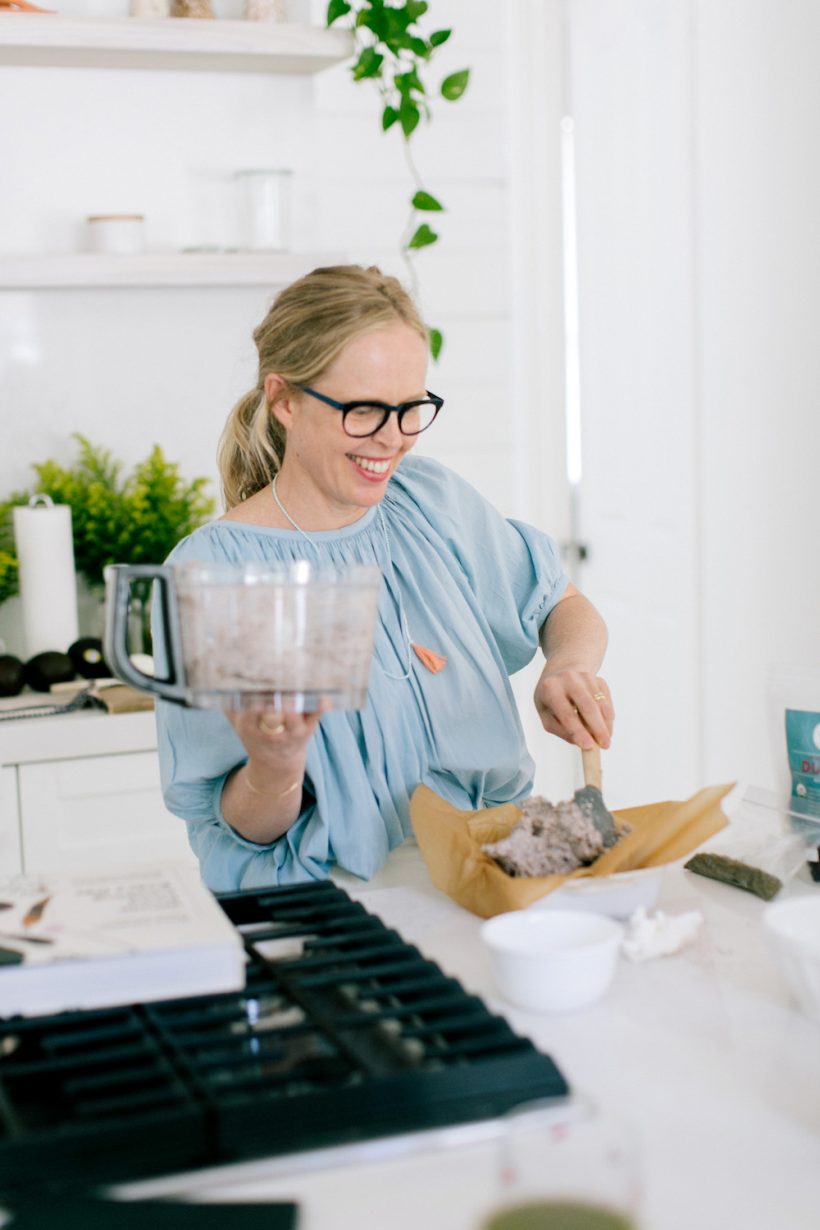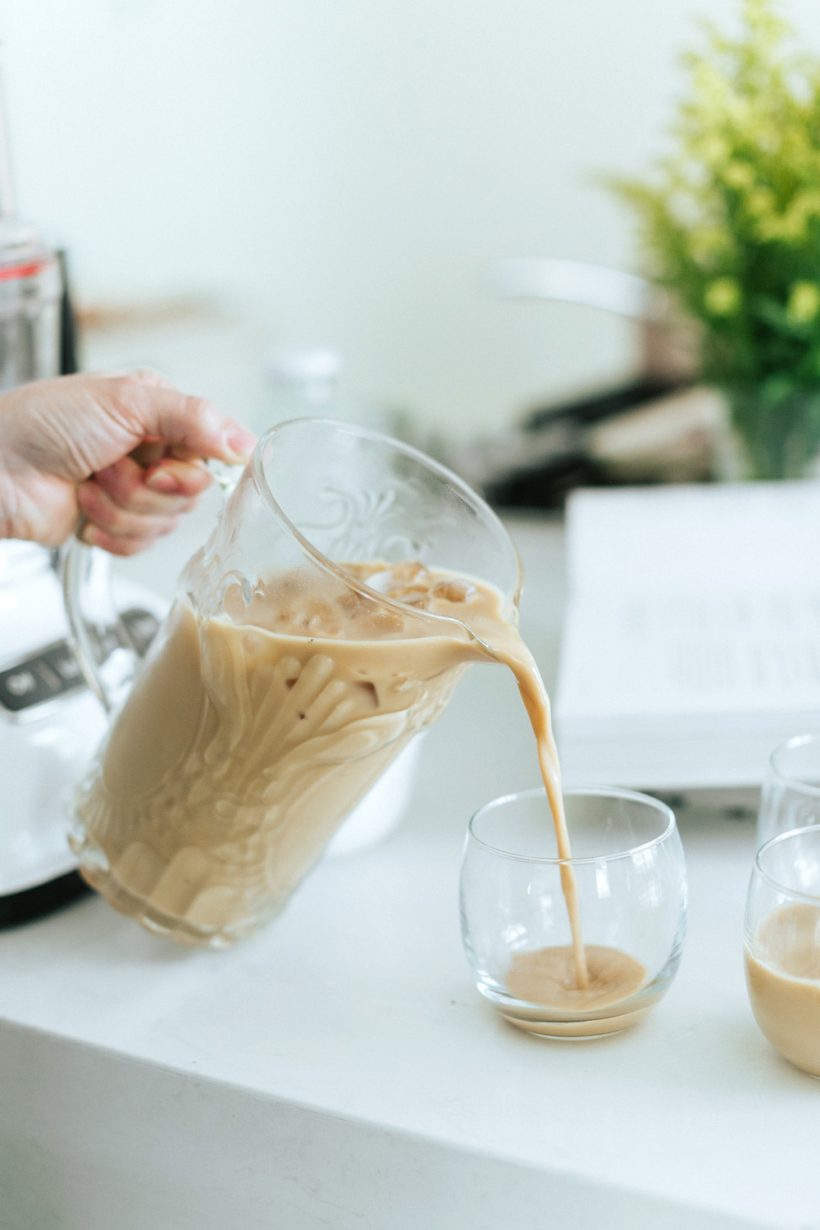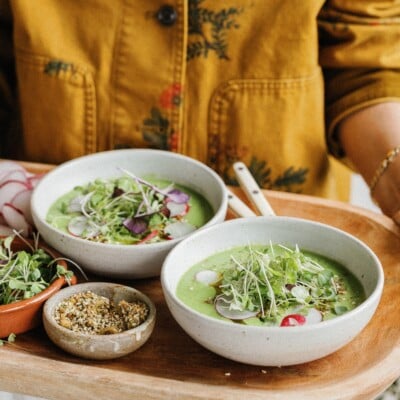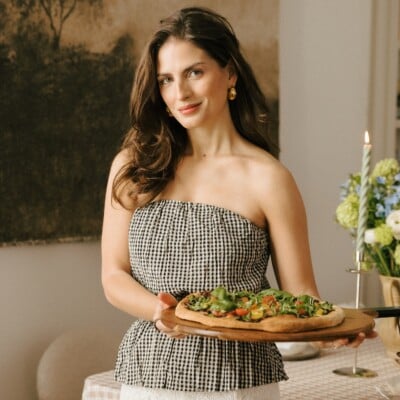The best teachers are those whose passion for their subject is contagious. They inspire a curiosity that makes learning feel like play, and in the realm of nourishing, wholesome cooking, I can think of few who embody this quite like Amy Chaplin.
I initially fell in love with Amy’s recipes when I got her first cookbook, At Home in the Whole Food Kitchen, a few years back. Her lessons on creating a well-stocked pantry and prepping for a week of delicious meals got me so excited about healthy cooking. Sure, her everything-from-scratch approach may not cater to those whose top priority is convenience, but for me, Amy’s writing awakens a deeper, more soul-nourishing approach to living and eating truly well. Her recipes inspired me to embrace her ethos of substance over shortcuts, assigning as much value to the process of preparing delicious food as to the act of eating it.
To celebrate the release of Amy’s incredible second book, Whole Food Cooking Every Day, she came to the bungalow and prepared a brunch featuring recipes from the cookbook for a few friends and me. It was one of those gatherings where the positive energy, connectedness, and nourishment to body and soul were palpable. I won’t soon forget it, and Amy was sweet enough to answer all my questions about how she enjoys good food every day.
Read on to get to know Amy, and scroll to the bottom for one of my favorite recipes from her book.
Tell me about how you ate growing up in New South Wales (in Australia). How has it informed your cooking today?
Vegetables from our garden and whole food pantry staples shaped every meal I ate growing up. Along with my mother’s home made tofu and my father’s sourdough bread, we ate extremely well. Not only were my parents serious about composting, gardening and making food from scratch, so was the whole community. Social gatherings revolved around great homemade food—in rural New South Wales there were no other options. Eating food made with such high quality ingredients informed the pure flavors and quality I seek out in my every day ingredients and meals.

Your passion to teach others comes through so clearly in your books. I still start every Sunday by soaking the grains and nuts I’m planning to use that week, thanks to your guidance. How did that play into the unique structure of the book?
Whole Food Cooking Every Day is based on the premise that all chefs and experienced home cooks know: successful meals come from good ingredients, reliable techniques, and a collection of go-to recipes that are so familiar they become second nature. Intuitive cooks can adapt methods and basic recipes to suit the season, the occasion, and the needs and desires of the people they’re feeding, as well as their own cravings.
ed. note: Each chapter of the book centers around a foundational base recipe, with a myriad of riffs and versions that home cooks can try once they master the basic version. For me, it’s the culinary equivalent of Pablo Picasso’s quote, “Learn the rules like a pro, so you can break them like an artist.”
pictured above: iced earl grey tea with nut milk and rose water.
What would you tell a beginner who has previously relied on processed foods and feels that they don’t have time or the ability to cook with whole ingredients “from scratch”?
Learning some key base recipes — whether for a chia Bircher bowl, salad dressing, nut milk, or soup, will not only enable you to prepare healthy meals and get the most out of your whole food ingredients but also help you become a better and more confident cook. The base recipes included in my newest book are the building blocks of my cooking routine. Every recipe in the book can be made in advance and used in a myriad of ways. I’ve found that it’s easiest if you devote a chunk of time, maybe a couple hours on the weekend, to knocking out lots of recipes at once and stocking your fridge and pantry with everyday staples that’ll carry you through the week.
Okay, it’s Sunday evening, and I’ve come home from the grocery store. I’m ready to meal prep for the week. What are 3 things that you’d advise me to prep to set me up for the week ahead?
- Beans. Get a batch of garbanzo (or other) beans that you can quickly put in the pressure cooker the next day, and can be the foundation to so many different meals.
- Dressing. Mix up a batch of dressing that can serve as the key flavor component of simple grain bowls, salads, and toasts all week long.
- Soups. Especially in the cold weather months, I love a warming blended vegetable soup, so having a batch of my Rosemary Butternut Squash Soup (scroll down for the recipe) or Parsnip Miso soup ready to go gets me way ahead of the game.

Who are your dream dinner party guests?
For me, it’s more about the type of person than it is about hosting someone impressive or famous. I love cooking for people who take joy in eating simple, whole ingredients that celebrate nature’s bounty. Cooking in a relaxed way, and feeding people without feeling any need to impress them, is what makes me really happy.
Dana illustrates it perfectly, above.

Any tips for finding time to meal prep when things are busy?
- Stop from time to time to do dishes, clean the counters, and clear your mind.
- Make a physical list — write down what you need to do in order so you can glance at the list if you get distracted; plus, crossing items off as you go is a true joy!
- Fill the largest bowl you have with water for washing produce. Start with the cleanest veggies/fruits, then use the same dater to wash anything gritty, like cilantro and greens.
- When you don’t know where to start, put the kettle on to boil. You can use boiling water to infuse flavorings for nut milks, make a batch of dandelion coffee, and speed up soup making, among other tasks.

Jen and Jordan toast with matcha lattés. Jordan owns Fronks, the insanely delicious nut milk that was the base of our lattés, blended with matcha tea from Rishi.

On a perfect day, what would you eat for breakfast, lunch, and dinner:
- Breakfast: A comforting porridge made with soaked grains — like my millet-coconut porridge with pear and cardamom. I may top it with a little nut milk, then I’d use that nut milk as the base for a golden milk latté.
- Lunch: A bowl of beans, roasted veggies, an egg, avocado, and some toasted seeds.
- Dinner: A simple soup made with vegetables is often my choice, especially when the autumn chill sets in.


above: Amy sprinkles boiled eggs with Dulse Rose Za’atar from the book. There was lots of extra za’atar, and I can say from experience that it’s literally good on everything.
What ingredients will we always find in your fridge or pantry?
- Avocados (of varying ripeness)
- Kale and other sturdy seasonal greens
- A few different types of sauerkraut
- Sunflower sprouts and microgreens
- Good quality nut butters for when I can’t make my own
- Sourdough or sprouted bread, sliced and frozen.

ed. note: I’ve developed quite an obsession with this black sesame bread recipe from Amy’s cookbook. Like her other recipes, it’s gluten, dairy, and sugar-free, and it gets the most satisfying crunch when toasted. I slice it up then freeze it, so it’s always ready for me to toast and top with avocado and eggs, like we did here.

How do you “live life like you mean it” every day?
I try to truly be in the moment for as many moments as possible (especially now with a baby as I know how fleeting this time in his life is).
I love inspiring people to cook, support local farmers and compost and like to think the ripple effect helps support improving the environment.


Scroll on for the recipe for Amy’s Rosemary Butternut Squash Soup with Toasted-Hazelnut Milk from Whole Food Cooking Every Day, and be sure to grab your copy of the book here for lots more delicious and healthy recipes!
Rosemary Butternut Squash Soup with Toasted Hazelnut Milk
Serves 8
How Plant-Based Chef Amy Chaplin Makes Every Day Delicious
Categories
Ingredients
- 2 tablespoons extra-virgin coconut oil
- 1 medium yellow onion, diced
- 3 large garlic cloves, finely chopped
- 3 tablespoons chopped fresh rosemary
- 2 teaspoons fine sea salt, plus more to taste
- 1 large (4 pounds) butternut squash, halved, seeded, peeled, and cut into 1-inch cubes (about 10 cups)
- 7 cups filtered water
- Freshly ground black pepper
- 2/3 cup raw hazelnuts, toasted and skinned, plus more for garnish
- Extra-virgin olive oil for drizzling
Instructions
- Warm the coconut oil in a large pot over medium-high heat. Add the onion and cook for 6 to 8 minutes, until beginning to brown.
- Stir in the rosemary, garlic and salt and cook for 3 to 4 minutes, until the garlic is golden and fragrant.
- Add the squash and 5 cups of water (the water should come almost to the top of the chopped squash), raise the heat, and bring to a boil; then cover the pot, reduce the heat to low, and simmer for 12 to 15 minutes, until the squash is tender. Test by pressing a piece of squash against the side of the pot; it should crush easily with a little pressure.
- While the soup cooks, put the hazelnuts and 2 cups water in an upright blender and blend until smooth; pour into a jar and set aside.
- Remove from the heat, season with pepper to taste, and set aside to cool slightly.
- Working in batches, scoop the soup into an upright blender (filling it no more than two-thirds full) and puree on high speed until smooth and velvety, then pour into a large bowl or another large pot.
- Stir in the hazelnut milk and season to taste with more salt and pepper. Serve the soup topped with chopped hazelnuts, pepper, and a drizzle of olive oil.
- Store leftover soup in jars in the fridge for up to 5 days, or freeze for up to 3 months.









